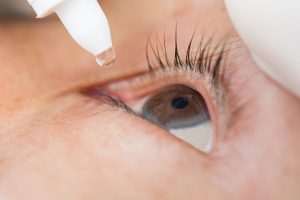 Chemosis is an inflammatory condition referring to a swollen conjunctiva; the mucous membrane that covers the sclera or the whites of the eyeball. Swelling of the conjunctiva can lead the eye to become irritated and presents as the outer surface looking watery or gelatinous in appearance. Chemosis is a non-specific symptom that can have any number of different causes.
Chemosis is an inflammatory condition referring to a swollen conjunctiva; the mucous membrane that covers the sclera or the whites of the eyeball. Swelling of the conjunctiva can lead the eye to become irritated and presents as the outer surface looking watery or gelatinous in appearance. Chemosis is a non-specific symptom that can have any number of different causes.
Advertisement
Also read: What causes brown spots on the sclera and how to get rid of it
What causes chemosis?
The job of the conjunctiva is to lubricate the eye by producing mucus and tears, though the majority of tears come from the lacrimal gland. The conjunctiva also serves as a defense against potential microbes from entering the eye that may potentially cause harm. When the defenses of the conjunctiva are active, it can become swollen, increasing the production of fluid leakage from abnormally permeable capillaries. This leads to the commonly seen presentation of chemosis, watery eyes.
There are a variety of causes of chemosis, with the most usual one being allergies, viral and bacterial infections, and constant rubbing of the eyes themselves. Any factor that can lead to eye irritation can lead to the development of chemosis.
The following are some of the most common causes of chemosis:
- Allergies: Seasonal changes, pet dander, pollen, and virtually anything else you may be allergic to has a high chance of making your eyes water and become itchy.
- Infections: Commonly caused by bacterial or viral infections leading to a condition called conjunctivitis. While these types of infection can be contagious, leading the eyes to become red, itchy, and watery, the specific symptom of chemosis cannot be transmitted alone.
- Eye surgeries: Performing any type of surgery to the eye or eyelid frequently leads to the development of chemosis. Fortunately, these symptoms usually only last a couple of days with appropriate treatment using eye drops, cold compresses, or temporary eye patching.
- Hyperthyroidism: A disorder of the thyroid gland leading to the overproduction of thyroid hormone. This condition can lead to several types of eye problems such as bulging of the eyes, eye puffiness, and retraction of the eyelids.
- Excessive rubbing: Constantly touching, rubbing, or scratching the eyes is a common cause of chemosis. Rubbing the eyes is never recommended as this will induce more irritation and possibly even cause eye damage.
Less common causes of chemosis include:
- Orbital cellulitis
- Acute glaucoma
- Obstruction of the superior vena cava
- Cluster headaches
- Urticaria
- Rhabdomyosarcoma of the orbit
- Parasitic infections
- Systemic lupus erythematosus
- Angioedema
- Dacryocystitis
- Carotid cavernous fistula
Symptoms of chemosis
Chemosis symptoms often include:
- Watery eyes
- Excessive tearing
- Eye itchiness
- Double or blurred vision
Chemosis sufferers may also have trouble closing the affected eye completely due to the swelling. It is recommended to seek medical attention if you begin to experience eye pain of any kind in combination with watery eyes as it may signal a more severe underlying eye condition.
How to diagnose chemosis
The diagnosis of chemosis will consist of a set of questions regarding intensity, irritation, pain, watering, and the oozing of fluid of the eyes, as well as any other presenting symptoms. It is also important to disclose any previous allergies or medical conditions you may have.
Close examination of the eyes will also take place, which will involve the use of specialized ophthalmologic equipment to see the extent of eye pathology. If need be, your doctor may also suggest getting imaging studies of the eye or they might perform a biopsy in cases where a tumor is suspected.
Treatment and prevention of chemosis
Treatment methodologies generally depend on the underlying cause of your particular case of chemosis. The following are examples of various treatments
Lubricating eye drops: Help combat dryness and irritation of the eye and is commonly prescribed in case of mild swelling.
Cold compress: Can provide immediate relief to reduce the intensity of chemosis, but only for mild cases.
Patching: Commonly done for patients who have difficulty closing the eye. Patching helps to prevent the eye from becoming excessively irritated and drying out.
Corticosteroids: Commonly given in the form of eyedrops to aid in reducing the eye’s inflammatory response and subsequently reduce eye swelling.
Anti-inflammatory medication: Can be topical or oral medication to aid in the reduction of inflammation and pain.
Anti-histamines: A common treatment for allergic reactions to suppress the release of histamine, a substance produced by the body when exposed to allergens.
Adrenaline or epinephrine: Standard emergency treatment for life-threatening anaphylactic reactions. An absolute must in cases where the patient is having difficulty breathing or swallowing.
Antibiotics: May be prescribed for bacterial infections that result in chemosis or post-surgical to reduce the risk of a secondary infection. This may come in the form of medicated eye-drops or ointments. Unfortunately, antibiotics are not effective against viruses.
Conjunctivoplasty: A minor surgery that involves performing a small incision into the conjunctiva and the removal of the excess membrane. This may be required in cases of prolonged swelling.
By avoiding potential allergic triggers, you can help reduce the occurrence of chemosis. It is also recommended to maintain a high level of personal hygiene to limit the sharing of personal items that may come into contact with the eyes, such as towels or cosmetic products. However, it is important to keep in mind that chemosis may not be preventable in some cases.
Advertisement
Related:
How to improve vision: 11 home remedies to improve eye health
Essential oils for pink eye (conjunctivitis): How to cure pink eye at home
